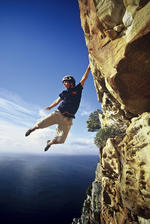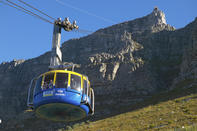Cape Town Mother City

Not only is Cape Town the Mother City, but Table Mountain can also claim to be the nursery of the country's rock-climbing fraternity (which is not to suggest that the ascents are always easy!).
Today, it has been claimed, Table Mountain is the most climbed mountain in the world. It has been declared a national monument and, although not sacred in the sense of Mount Fujiyama, occupies a special place in the hearts of all Capetonians.
How sad, then, that even this has not stopped people from defiling its slopes with eroded paths, litter, ugly developments and fire.
The Country's Most Famous Landmark

Antonio de Saldanha was the first man known to have reached the top of Table Mountain, and since he did so in 1503 the country's most famous landmark has attracted climbers of all kinds. By the 1790s rambling up Table Mountain was a popular pastime but the first man to become closely acquainted with it was the unlikely Joshua Penny.
An American, Penny was press-ganged into the Royal Navy and deserted HMS Spectre in Table Bay in 1799. To evade capture he took refuge among the Peninsula's mountains and spent 14 months living off the land. He lived near a spring in Fountain Ravine, killed buck with stones and wore their skins. He even made crude mead in a hollowed-out tree trunk.
'I never enjoyed life better than when I lived among the ferocious animals of Table Mountain,' he said. Buffalo, lion, elephant and leopard, in fact, many of South Africa's wild species, were first seen where the Cape Town metropolis now hugs the mountain.
Western Cape Mountainland
For the past two centuries, Table Mountain has been the centre of this country's climbing activity, but with the founding of the Mountain Club of South Africa in 1890 exploration of other areas of the western Cape mountainland began with great enthusiasm. Sepia photographs from the Edwardian era show large mountaineering parties assembled in front of railway coaches for country outings to the Hex River, Winterhoek and Drakenstein.
The first climber of note in South Africa was George Travers-Jackson who, from its inception, was an active member of the Mountain Club for more than 50 years. He quickly established a high standard of mountaineering and an adventurous attitude to route finding. Then came Ken Cameron, the Berrisfords and the brilliant George Londt.
In about 1920 Londt became the leader of an energetic climbing group that opened many new climbs on Table Mountain. He was a short but powerful man and because he did not have the reach of other climbers, made up for this limitation by becoming a great innovator of climbing technique.
In 1920 he led the first frontal attack on the Klein Winterhoek, a magnificent peak above Tulbagh that has 400 metres of climbable rock and is now a classic country route. Then, on 13 November 1927, the herculean, meticulous Londt, who had never put a foot or hand wrong, fell to his death on Table Mountain. His only mistake was his last, and the argument as to how he could have fallen on a relatively simple climb continues.
By David Bristow